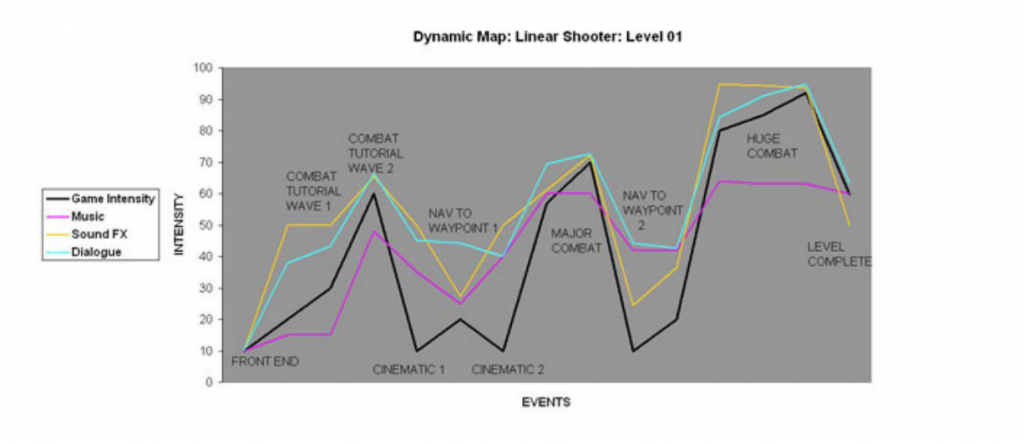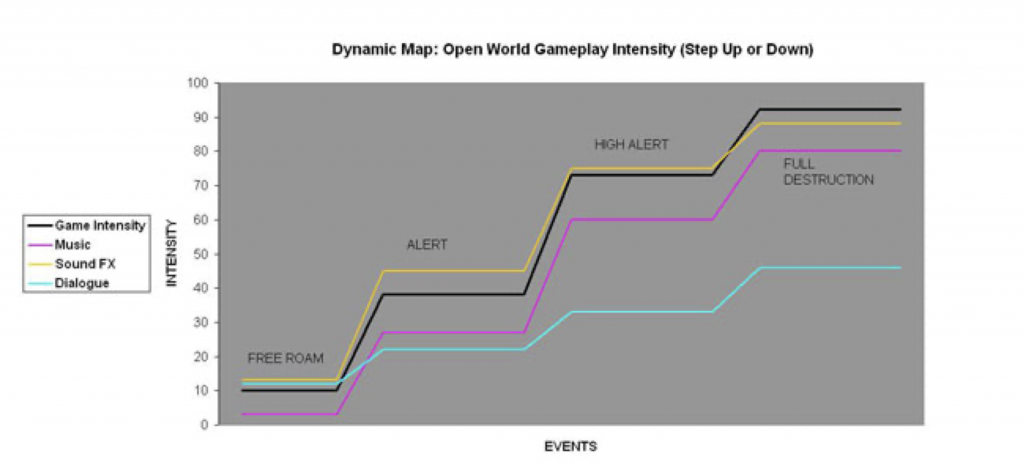I have decided to research adaptive music in games as I am not educated in composing non-linear music for games, therefore it is crucial I understand how to do this effectively before beginning to structure my composition. Therefore I will research into the different elements of video game music such as; loops, states, stingers and more in order to learn how professionally compose non-linear video game music for the ‘Wwise Adventure Game’.
What Is Adaptive Music
Unlike a movie, a video games gameplay direction is controlled by each individual players free will, this means the developers and the music cannot predict how each player will tackle specific gameplay encounters. Therefore video game music must be written in a specific way to adapt to the players actions within the video game. One of the biggest challenges when writing video game music is to make sure it doesn’t get boring for the player to listen to, as we cannot predict how long the player will spend in one area where the music is playing. To compose video game music you mist own an audio middleware such as Wwise, a middleware is used to manage the settings of the audio in the video game and how it behaves. Adapting music to video games is a very difficult challenge at first, however there are many techniques used to write music for adaptive games which I will talk about on this page.

Layering
Layering in video game music is when instruments are slowly added to the score as the player progresses through the level and hits video game markers (MasterClass Articles, 2021.) This is done by composing a music loop as usually, however some of the instruments will be muted until the player does a specific action. Furthermore this allows the music to evolve and grow as the player works their way through the level, therefore allowing the player to feel like the music is adapting to their own gameplay and the world around them. An example of layering would be if the player is sneaking around the level undetected, in this scenario the music could be playing a tense melody with some mysterious chord progressions. However if the player was to get spotted the music may unmute a percussion track to give the music a sense of danger and action due to the player being spotted. To programme layering into a middleware or Wwise you must strip down your instrumental arrangement into sub-mixes and make sure the appropriate layers are grouped together. From there you can programme the middleware to add or remove layers according to the different actions on screen (MasterClass Articles, 2021.) A few games you may now that use layering are the early Metal Gear Solid games and the Little Big Planet franchise.
Music Blocks
A music block is when the composer writes a small piece of music that loops over until the player reaches a specific event, this is when the music will then transition to music block B then eventually C (MasterClass Articles, 2021). Some examples of when a music block might switch may when the player; enters a new location, collects a certain amount of points or talks to a significant character. There are two main types of music blocks in video game music which are, linear and dynamic music block loops. I will talk about both of these types of music blocks later on in this page. However the main function of music blocks is to capture the mood and atmosphere of the location the player is in and the significance of it in relation to the narrative of the video game. Music blocks are sometimes randomly shuffled in a random looping playlist to avoid the player from getting bored of the same music in the level. However the transitions composed to be very smooth using techniques such as cross-fading to prevent the music from breaking the players immersion. A game that uses music blocks is Doom Eternal, in this game the music transitions to different music blocks depending on what state of combat the player is in. For example the music will change to a music block that contains very intense music when the player is in the final battle of the level, however then the player is fighting smaller cannon fodder enemies the music block will be more ambient and relaxed.

States
A state in video game music is when two pieces of video game music are written and played at the same time with the game, however one of the tracks will be on mute while the other is played out loud in the game (MasterClass Articles. 2021). When the player reaches a certain event within the game the two tracks will crossfade and switch places In terms of dynamics. A great example of cross-fading in video games is in Super Mario Odyssey when the player transitions from the 3D world to an 8-Bit world. To reflect on this change the music cross-fades from an orchestral score to a re-arranged 8-Bit version of the score (MasterClass Articles. 2021). Music states in games however can work in may different contexts such as, transitioning from stealth to combat music during action games.
Ambient Music and Random Phrases
This technique is similar to the music ‘block method’ as the music has multiple ambient layers that play beneath the gameplay (MasterClass Articles. 2021). However there is an extra layer of audio in the track which consists of small musical phrases which play throughout the level. The phrases are randomly shuffled to give avoid the music from becoming boring to the player, one video game which uses this methods is Uncharted: The Lost Legacy’s opening level (MasterClass Articles. 2021). This technique works very well in this level as the phrases fade in and out of the music creating a mysterious and tense atmosphere within the gameplay due to the long reverb and decay on the instruments.

Stingers
Stingers are short musical phrases which play when the player completes a certain action within the game, stingers are usually separated from the rest of the levels music using silence (MasterClass Articles. 2021). Stingers have been used very frequently in horror games and movies such as; Jaws, Friday the 13th and the Scream franchise. This is because the silence within these movies creates tension, as our minds expect something to break the silence however we do not know when therefore it provokes fear. From this point stingers are often used to create loud and abrupt dynamic spikes to scare the viewer, this technique is also used in a very similar way in horror games such as outlast and alien isolation. Stingers are also used very commonly in mobile games due to their short file size and they’re effective use, you may have heard stingers in games such as Clash of Clans when you win a raid. These music phrases are often played by triumphant trumpets and horns to signify power and victory over the enemy.
Above this text is an example of one of my favourite stingers that plays when the character, Mario grabs a special item within the game. The general mood of this piece of music sounds very triumphant and happy, the music takes this tone by using numerous musical techniques. First of all the music is written in a major key, which also uses mostly major keys. This harmony within the music has a very happy and uplifting tone which is partially due to the uplifting key the music is written in. The ascending melody played by the trumpet creates an elevated and bright tone within the music which creates a sense of victory within the music. The timbre of the trumpet also has a bright and victorious tone, this further reinforces the triumphant theme of the music. Beneath the trumpets melody the harp is playing a fast arpeggio which plays in an 8th note rhythm. The fast rhythm of the harp gives the music a sense of movement and energy which gives the music an uplifting and happy tone, this reflects on the playful nature of the video game. The final musical element to this sting is the percussion which consists of timpani rolls and crashes. The timpani rolls create a build up within the music which creates anticipation towards the climax of the sting. The crashes create a sense of importance and superiority due to the intensity of the cymbals sound. Furthermore all the elements within the percussion of this sting create a sense of significance within the music, which reflects on the character on screen collecting an important item.
Dynamic Audio In Video Games
In all genres of video games music is very important and effective tool in vide game development when the developers would like to empower the narrative experience. The soundtrack of a video game can very powerful when corresponding to visuals in the video game, this is because music has a huge influence on our initial interactions with characters and locations. For example if you meet a character for the first time and the dialogue is accompanied by light and holy music, you will begin to see the character as friendly and good. This is because the music has already told you what to think about the character before you have time to forge your own opinion. A very important part of the game’s narrative experience is mapping the narrative gameplay events to their intensity in the game. Dynamic range is very important when it comes to creating a video game, this is because dynamics in video games is the difference between the least intense and most intense gameplay/narrative moments. To avoid the listener/player getting bored of the soundtrack the intensity of the music should vary between each event. Furthermore creating a dramatic curve which amplifies the narrative experience of the video game.

Above this text you can see a graph showing the variations in dynamic intensity throughout one level during in a shooter game. This graph suggests that the dynamics are the most intense during the level while the player is in combat, the intensity of the dynamics also increase as the scale of the combat increases. Dynamics to create intensity during combat to reflect on the intense situation the character is in, as one mistake can lead to the death of the player. As you can see in this graph the intensity of the level is at its highest when the player is in the ‘huge combat’ part of the level, the loud dynamics in this situation reflect on the deadly and high stakes gameplay. This graph also shows that the music is the least intense when the player is traversing/exploring the level and watching cutscenes. This is because primarily in video games during cut-scenes the developers want the players to focus on the visual narrative of the game, to do this they take away attention from the video game using softer dynamics. One part of key information in this graph is that the music is always on a quieter dynamic level than the dialogue and SFX, this is because the SFX and dialogue may give the player important pieces of information such as their health being low or dialogue relevant to the story. Therefore the music is quieter to allow the SFX and dialogue to be heard. In summary of this graph the dynamics of the level swell up until the climax huge fight at the end of the level.

The graph above shows the dynamic intensity of the audio in an open world video game. Due to this video game being open world this means that the music cannot predict the players next action, meaning the music must adapt to the players gameplay decisions in real time. As you can see in this graph there are 4 states of dynamics within the open world game which are; free roam, alert, high alert and full destruction. Usually in open world games such as; Elden Ring, Skyrim and Fallout the music composition transitions to the next part of the music’s structure when the player encounters a new event. The dynamics in this game can step up or down depending on the action the player is taking part in, which can create a unique and interesting non-linear musical experience for the player. In this graph you can see the dynamics raise as the player becomes more alert to danger, and the dynamics peak when the player engages in combat or ‘full destruction’.
Video Game Loops
Linear Loops
A video game music loop is a piece of music that repeats over the gameplay, loops are needed in games as we cannot predict how long a player is going to be spending on specific areas of the video game (Kejero, 2012). Therefore the music must adapt to every players gameplay experience in order to maintain their immersion in the gameplay. Linear music loops were also originally made to save space on video game hard drives, as in the early stages of game development game developers did not have much storage on computer hard drives and video game loops did not cost much data storage (Shaw, 2019). Musically advanced gameplay loops have been around since Rally-X (1980), accompanying the player while they race around the video games tracks. There are two types of video game loops, which are linear and dynamic loops (Aska, 2017). A linear gameplay loop repeats once the music finishes and plays the exact same way as before, during the gameplay linear loops will repeat endlessly until the game tells them otherwise. One reason the loop may stop could be because the player has finished the level or completed a boss fight, the music would then change to another piece of music or maybe even another linear loop. An example of linear looping can be seen in the Mario Overworld soundtrack composed by Kojo Kondo (Aska, 2017). In one of the linear loops the music did repeat upon finishing, however he programmed it so each time the loop repeated the structure of the motifs where re-arranged. This helped prevent repetitiveness to the non-linear loop by adding an element of unpredictability to the music.
Dynamic Loop
A dynamic loop is a video game loop which makes minor changes to it’s self each time it loops over, the main intent of a dynamic loop is to prevent the music from becoming boring to the player while keeping the original musical motif in the soundtrack. One example of a minor change which could be made in an orchestral dynamic loop would be to change the instrumentation of the track while the music is continuously playing (Kellman, 2020). This looping technique is often used in games which have short musical loops such as mobile and casual games. Martin O’ Donnel (Halo Soundtrack) said that the most important feature of dynamic looping is that it contains enough “permutations and the proper randomisation” each time the music loops so that the players do feel like they are hearing the same music over and over (Kellman, 2020).
How To Compose a Loop
An effective technique used when composing video game music loops is to finish on the same or harmonically related note or chord that started the piece of music, this will allow the music to loop without interrupting the flow of the music (Shaw, 2019). Another important element when creating seamless video game loops is rhythm, this is because a dramatic and epic drum fill at the end of the loop will be exhausting for the player to listen to when the percussion immediately returns to it’s state at the beginning of the music. Therefore it is important to have a “stimulating yet repetitive groove” in the rhythm of the music (Shaw, 2019). The final thing to be aware of when composing video game loops is dynamics, this is because composing music with loud dynamics at the end will sound very abrupt and lazy when the dynamics suddenly lower as the music loops back to the start. Therefore if you want to include dynamic variation in the loop it is best to put it in the middle of the loop rather than the end, as it is much easier to professionally descend the volume of the music to it’s original volume by the end of the loop (Shaw, 2019).
Source List
Alchemy Studio. 2016. Adaptive Game Music 2 in Music – UE Marketplace. [online] Available at: <https://www.unrealengine.com/marketplace/en-US/product/adaptive-game-music-01> [Accessed 7 April 2022].
Aska, A., 2017. Introduction to the study of video game music. n.d.: Lulu, pp.69 – 72.
Baggström, M., n.d. How to write Adaptive Music for Video Games. [online] Professional Composers. Available at: <https://professionalcomposers.com/how-to-write-adaptive-music-for-video-games/> [Accessed 7 April 2022].
IMDb. 2016. Uncharted 4: A Thief’s End (Video Game 2016) – IMDb. [online] Available at: <https://www.imdb.com/title/tt3334704/> [Accessed 7 April 2022].
Kellman, N., 2020. The Game Music Handbook: A Practical Guide to Crafting an Unforgettable Musical Soundscape. [ebook] Oxford: Oxford Unity Press, pp.3 – 15. Available at: <https://books.google.co.uk/books?id=FQgCEAAAQBAJ&printsec=frontcover&source=gbs_ge_summary_r&cad=0#v=onepage&q&f=false> [Accessed 26 May 2022].
Kuchera, B., 2021. https://www.polygon.com/2021/3/18/22337900/doom-eternal-ps5-xbox-series-x-upgrade-options-id-software. [image] Available at: <https://www.polygon.com/2021/3/18/22337900/doom-eternal-ps5-xbox-series-x-upgrade-options-id-software> [Accessed 7 April 2022].
MasterClass Articles. 2021. How to Compose Music for Video Games. [online] Available at: <https://www.masterclass.com/articles/how-to-compose-music-for-video-games#how-to-become-a-video-game-composer> [Accessed 7 April 2022].
Musical Toasters, 2019. Grand Star Get – Super Mario Galaxy Music. Available at: <https://www.youtube.com/watch?v=9IhNOBrpgJ4> [Accessed 7 April 2022].
Music by Kejero, 2012. A Very Basic Intro to Adaptive Music in Video Games. Available at: <https://www.youtube.com/watch?v=tP8bjaUYttc&t=158s> [Accessed 7 April 2022].
Shaw, D., 2019. Continuous atmosphere: the art of looping soundtracks for video games. [online] Happy Mag. Available at: <https://happymag.tv/continuous-atmosphere-the-art-of-looping-soundtracks-for-video-games/> [Accessed 7 April 2022].
Peerdeman, P., 2010. Sound and Music in Games. [ebook] Amsterdam: VU, pp.4 – 5. Available at: <https://peterpeerdeman.nl/vu/ls/peerdeman_sound_and_music_in_games.pdf> [Accessed 26 May 2022].